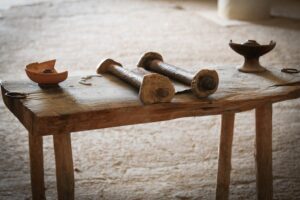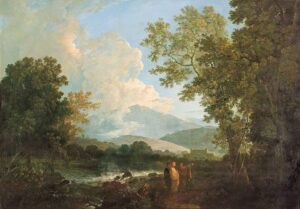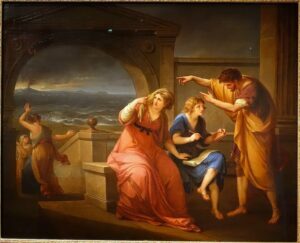
Along the Argiletum, a heavily trafficked street in old Rome that led down from the summit of the Esquiline Hill, then through the Subura quarter, entering the Forum Romanum between the Senate House and the Basilica Aemilia, one could encounter a daily microcosm of the city’s populace.
A person could stake out a shady sidewalk spot beneath an umbrella pine and divert themself for hours just watching the ceaseless river of changing faces flow by. The eclectic multitude might include a prominent senator, with a conspicuous entourage of bodyguards, an obnoxious man of great wealth with a cadre of obsequious clients, actors, bankers, businessmen, teachers and teenagers, ladies of the social register, down-and-outers, veterans, and pickpockets.
Their one common denominator?
A passion for good books.
The Argiletum, you see, was Rome’s answer to London’s Paternoster Row, or New York’s ‘’Publishers Row” on 5th Avenue, i.e., the heart of the publishing and book-selling trade. Many of the Eternal City’s publishers not only had their offices along the clamorous paved thoroughfare, but their factories and retail outlets as well. It was also a rendezvous for the distinguished literati of the day who would be on hand to help promote sales of their latest “volumes.” (The Romans often used the word volumen instead of the word liber for book.)
And what did a book look like in Roman times? While no original manuscripts survive, archeologists excavating Herculaneum – the other city buried, like Pompeii, in A.D. 79 by the eruption of the Vesuvius volcano – discovered a house with an extensive library of eight hundred plus “books,” i.e. scrolls, that afford us the answer to that question. These consisted of long strips of fine bark papyrus imported from Egypt. After the papyrus had been pressed into “sheets,” it was pressed a second time and sun-dried before being cut into “page” widths that could be written on, on one side, with a stylus dipped in ink made from lampblack. These pages would be glued one to another at the edges and then rolled tightly around two wooden rods, or dowels, about twelve inches long. The last leaf, or page, would be fastened to the right hand rod. The left hand rod would serve as the take-up reel. The reader would hold the “book” with both hands and unroll it from right to left until a page was centered between the two rods, and repeat this step for each subsequent page. These books ranged in length from as little as six feet (a pamphlet) to as much as sixty feet or more for an edition, say, of Virgil’s Aeneid.
Each of the rods would be tipped with metal or ivory for decorative purposes. To the top end a small tag of parchment bearing the title, and perhaps the author’s name, would be attached, hanging down when the book was placed on its side in a bookcase.
There were no breaks between the words nor the sentences. There was no paragraphing nor punctuation. These devices were introduced in later centuries as a service to the reader.
___________________________

The beginning of what we know of today as books made its premier as the unrolling scroll. Smufotos, Pixabay
___________________________

Photos of the papyrus fragments PHerc.1103 (a) and PHerc.110 (b,c). Image contrast and brightness were enhanced to better visualize the details visible to the naked eye on their external surface. Sara Stabile, Francesca Palermo, Inna Bukreeva, Daniela Mele, Vincenzo Formoso, Roberto Bartolino & Alessia Cedola. Creative Commons Attribution 4.0 International, Wikimedia Commons
___________________________
**********
Up to the first century before Christ, the publishing business was virtually non-existent. There were as yet no public libraries and the literacy rate was woefully low. In the Roman world of letters, such as it was, authors would produce copies of their writings in their own homes for distribution among friends and kin.
Cicero however, the great statesman, orator, and essayist, had the advantage of a wealthy entrepreneurial friend, Titus Pomponius Atticus, who put his corps of skilled slaves to work mass-producing editions of Cicero’s manuscripts. When Atticus noted the literacy rate significantly growing, and the ever increasing market of book lovers, the astute financier jumped into the publishing business with both feet. He soon entered into agreement with a number of accomplished poets, satirists, story-tellers, biographers, and historians. Naturally Cicero, the master wordsmith of the day, headed his list of authors. It was a stroke of genius on Atticus’ part to add to his portfolio a bookshop and a publishing firm. He quickly struck gold with beautiful editions of the two most brilliant of all Ciceronian essays: De Amicitia (on Friendship) and De Senectute (On Old Age).
In a letter to Atticus from 13 February in 61 B.C., Cicero had pointed out the high real estate values on the Argiletum:
“My brother Quintus has purchased the remaining three-quarters of the Argiletum property for 735,000 sesterces.
(Classical scholars calculate that today such a sum would come to about 350,000 U.S. dollars.)
Accordingly, Atticus established his production plant in that fast developing business district. The establishment had a room where slaves pressed the papyrus into sheets, another where they glued the edges together. In the third room – a rather large hall in fact – dozens of his workers skillful in penmanship sat at drafting tables and wrote feverishly on these sheets, while a reader at a lectern dictated, in a loud, deliberate voice, from the original manuscript.
Another word or two, now, about Marcus Tullius Cicero. “Tully,” as third-level Latin students and their teachers fondly refer to him, maintained a prolific correspondence which was destined to have a significant impact on the nascent book-making industry. Tiro, Cicero’s intellectually gifted Greek slave – whom he dearly loved and treated as a member of the family – carefully wrote out the great man’s dictated letters and always made a second copy of each, which he meticulously maintained in a file. After his master’s death in 43 B.C., Tiro turned over some nine hundred of them for publication by the firm of Titus Pomponius Atticus. Their release met with such wide acclaim and wild enthusiasm that soon letter-collections of prominent Romans became a popular new literary form with avid readers, and publishers were only too eager to accommodate this growing mania.
________________________________

Cicero with his friend Atticus and brother Quintus, at his villa at Arpinum. Public Domain, Wikimedia Commons
________________________________
In the late first and early second century A.D., the personal correspondence of Pliny the Younger topped the sales charts on the Argiletum. These epistolary writings of such literary celebrities afford the modern reader fascinating and authentic insights into numerous aspects of Roman life, e.g. the leisure interests, the politics, the culinary preferences, the religious beliefs and practices, the medical advancements, the family unit, the home decor, the raising of children, the legal profession, the variety of occupations, the compulsory military service, the ownership and treatment of slaves, the entertainment industry, the government welfare programs, the holiday festivals, the trade and commerce, the frantic pace of urban life vis-a-vis the tranquility of residence in a country villa, summer vacations, travel abroad, the Zeitgeist, and so much else of each era of Roman antiquity. All this made for very scintillating reading and a new, very marketable genre for the publishers.
________________________________

Pliny the Younger and His Mother at Misenum. Painting by Angelica Kauffmann, Exhibit in the Princeton University Art Museum. Public Domain, Wikimedia Commons
________________________________
According to Martial, the first century poet, Roman readers could be quite discerning, fussy if you will, about choosing a book:
“The people of Rome have demanding tastes in literature. The young, the old, even the children have the nose of a rhinoceros [an idiom meaning, back then, knowing how to judge well].”
In 39 B.C., as the literacy rate continued to grow dramatically, the affluent C. Asinius Pollio founded a for-profit lending library on the Aventine Hill. With the resultant growing demand for books, the fledgling publishing trade began to flourish and more and more companies and shops blossomed on the Argiletum. Just before his assassination, Julius Caesar had plans in the works to build the first State Library. It was left to his successor Augustus to complete the ambitious project.
Libraries began to be organized in the provinces and municipalities throughout the empire. By the end of the first century A.D. there were numerous such facilities – as many as twenty-nine in the capital alone, the most impressive among them being the twin libraries built by Trajan, one stocked entirely with works in Latin, the other in Greek. (Interesting note: it was considered the height of bad manners for a library patron to return a book without rewinding it to the first page, as a courtesy to the next borrower.)
In addition to all this, there was now a private collection craze for the publishers to satisfy, as well. Good home libraries tended to include as many as three or four hundred volumes. Book collecting by this time had also become a status symbol and a form of ostentation. (A book was a most welcome gift to bring along if one were invited to a dinner party.) Cicero would say: “A house without books is like a body without a soul.” He would then add: “If you have a garden and a library, you have everything you need to be happy.”
The beginning of Rome’s Imperial Age also saw the establishment of a sort of canon of literature to be taught in the schools, thereby further spiking the output of the publishing companies. Publishing houses soon dominated the Argiletum. Quintilian the rhetorician and Martial the satirist both mention the firms of Tryphon, Attrectus, and Secundus. Horace (first century B.C.) had told of another. After instructing his readers on what should go into a volume of poetry, he writes:
“Brothers, Hic meret aera liber Sosiis (Such a book would be a real money-maker for the Sosii).”
We also see references by other writers to the publishing houses of Dorus, and Q. Pollius Valerianus. All these were the MacMillans, Random Houses, and Simon and Schusters of that day and age.
**********
While the idea of royalties was still unknown, the publisher and author surely must have reached some kind of share-the-profit agreement. Of course, first time and unknown authors, desperate to have their work produced, show-cased, and disseminated, would settle for a pittance. But then, even well-known writers could, from time to time, be exploited.
Publishers grew rich by shipping their neatly packaged products to Gaul, Spain, Illyria, Sicily, North Africa and other distant provinces. Martial liked to boast that his works were being read and quoted by soldiers deployed in far off Britain, but then complained: “I don’t make a dime off it.”
A publisher would try to estimate the demand and market for any new manuscript and then put as many copiers as called for to work on its production. No copy left his establishment until the whole edition – anywhere from a hundred to two hundred – was ready.
Since copyright laws did not exist, a new publication could be easily pirated and mass-produced by a smaller firm in a cheap and unattractive issue.
By the mid-second century A.D. in addition to raking in huge profits from their provincial trade, the Argiletum dealers continued doing a thriving business right on the premises. The voracious reading, book-buying public would daily jam the street, seeking the latest best-sellers. Stores and stalls would hang advertisements in conspicuous places, giving the prices of new releases. Sometimes tantalizing excerpts would be posted for the convenience of browsers, who would swarm like flies around the entrance to each retail outlet.
In our time, an author of a newly released work is expected to help with the promotion and sales of it by book-signings, by doing interviews with journalists, and mostly, by making the rounds of popular radio and television talk shows. In Roman times, authors would hold readings from their newest efforts in private homes, on street corners, in theaters, in porticoes, and even in the Forum. Some of the more renowned writers might even be invited to the emperor’s palace to provide the entertainment portion of an elegant state dinner and on other special occasions. Hadrian, with his own funds, erected in the heart of Rome a spacious auditorium just for this purpose. The place drew an eager audience for every event.
Many poor illiterates often joined in, this being their only means to enjoy outstanding writing.
Often, an aspiring but as yet unpublished author would invite family and friends, neighbors and co-workers to a private reading of his latest manuscript. So as not to offend the nervous neophyte, most of the invitees would show up, though some with great reluctance. Lame excuses, for not being able to comply, abounded.
Literary clubs and discussion groups eventually also became commonplace – as did the expression: “What’s new on the Argiletum?” It was the golden age of Roman publishing.
In the late fourth century, a kind of industrial revolution hit the publishing trade. A new book format was introduced. This involved the use of parchment (dried and specially treated animal skins) cut into “pages” which could be written on, on both sides. These were numbered and stacked in numerical order, then stitched together in the back to form what was called a codex, or in other words, the prototype for books ever since. The companies lining the Argiletum had to adapt or perish, for the reading public quickly preferred the ease of turning pages to the cumbersome old way.
Today there is hardly a trace of the ancient book bazaar street. It courses somewhere beneath eighteenth century buildings and Mussolini’s Via dei Fori Imperiali. The short stretch of the Argiletum that penetrated the Forum Romanum is now overrun with weeds and shattered paving stones, and is busy playing host to a colony of vagrant cats.
_________________________________


